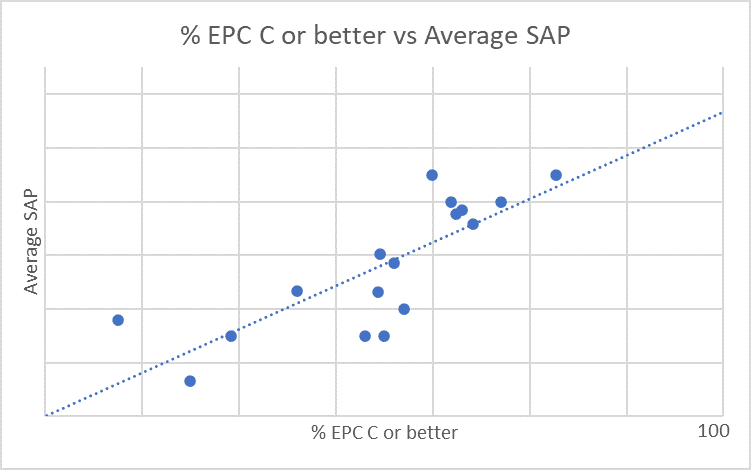At SHIFT we help landlords prepare roadmaps for net zero carbon. One of the things we have noticed is that including the new build departments in holistic net zero roadmaps can lead to significant savings to whole life costs. This is even if there is a little “over and above” costs for building better quality homes, beyond building regulation standard.
The main reason is that adding A rated new homes increase the average energy efficiency of stock much more than building regulation standard homes. This means that the remaining stock doesn’t have to be refurbished so much to reach an average net zero stock.
Here are two scenarios with some workings:
“Expensive scenario” – upgrade existing stock to net zero carbon and build just to building regs
Assuming 2% annual build rate and no disposals, by 2050 46% of homes under asset management will be new build with an average SAP of around 88 (i.e. EPC B)
To increase a current average SAP of around SAP 70 to a net zero equivalent for existing stock in this scenario it may cost an association around £50 million over the next 30 years. The bonus in this scenario is that there are no “over and above” costs for new build.
“Better all-round scenario” – build A rated homes and upgrade existing stock enough to bring average SAP to net zero
Assuming the same build rate as the previous scenario but now all new homes are A rated which is much higher than current building regulations.
Because 46% of stock is much higher energy efficiency, existing stock need only be upgraded to a lesser extent than in the previous scenario and costs may be around £27 million over the next 30 years.
The downside is that there may be an over and above cost for new build. However, even these costs may be offset with new technologies such offsite build, BIM and even 3D printing. But for this working, we will use the over and above costs assumed by the Committee on Climate Change. In this scenario the over and above costs may be £13.9 million.
Add this to the upgrade costs gives £40.9 million which is over £9 million pound more value for money than the “expensive” scenario.
What’s even better news, is that working to eradicate fuel poverty will help the path to net zero carbon considerably. Our SHIFT 2019 data projects what the average SAP of stock might be if 100% of homes are EPC C or better.

Health warning – we know that SAP is only a surrogate measure of CO2 emissions and that 2% build rate for the next 30 years is difficult to anticipate. Nevertheless, the message still stands, that the sooner a landlord starts adding A rated homes to its stock, the whole life costs of achieving net zero carbon are considerably lower.
If you’d like to know more about the thoughts in this article or would like a road map to net zero carbon please get in touch on [email protected]
